In the intricate world of natural camouflage, few creatures have perfected the art of deception quite like the Rhinoceros Viper (Bitis nasicornis) and its relatives. These remarkable reptiles have evolved an extraordinary ability to blend seamlessly with tree bark, creating an almost perfect illusion that transforms their bodies into what appears to be nothing more than cracked wood. This masterful disguise isn’t merely for defensive purposes – it’s a sophisticated hunting strategy that allows these ambush predators to remain virtually invisible until the perfect moment to strike. As we explore the fascinating adaptations, behaviors, and evolutionary history of these bark-mimicking serpents, we’ll discover how natural selection has crafted one of nature’s most effective optical illusions, allowing these predators to thrive in their forest habitats through the perfect combination of patience, camouflage, and lightning-fast strikes.
The Masters of Disguise: Introducing the Bark-Mimicking Snakes
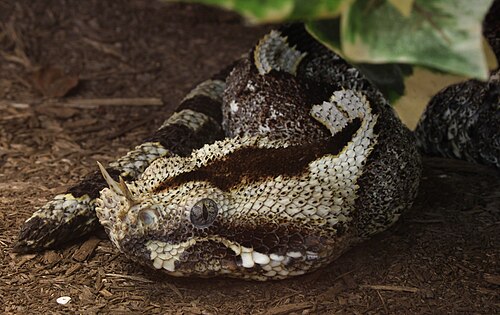
Several snake species around the world have evolved remarkable bark-mimicking camouflage, with the most famous examples including the Rhinoceros Viper (Bitis nasicornis) from Central and Western Africa, the Gaboon Viper (Bitis gabonica), and various species of pit vipers in the Crotalinae subfamily. Their coloration and patterning so closely resemble tree bark that even experienced herpetologists can walk right past them in the wild without detection. This extraordinary camouflage isn’t a happy accident but rather the result of millions of years of evolutionary refinement, where snakes with better camouflage survived at higher rates than those more easily spotted by predators or prey. The intricate scale patterns, strategic coloration, and even the physical texture of these snakes’ bodies contribute to creating what is essentially a three-dimensional replica of bark, complete with what appears to be cracks, lichen, moss, and shadows.
Evolutionary Development of Bark Mimicry

The evolution of bark mimicry represents a remarkable example of convergent evolution, where unrelated snake species have independently developed similar adaptations in response to similar ecological pressures. This evolutionary journey began millions of years ago as forest-dwelling snakes faced dual selective pressures: avoiding predation and successfully ambushing prey. Over countless generations, random genetic mutations that produced scale patterns and coloration more closely resembling bark were favored by natural selection, as these snakes survived and reproduced more successfully than their less camouflaged counterparts. The complex patterns we see today didn’t appear suddenly but emerged gradually through this evolutionary process, with each incremental improvement in camouflage offering survival advantages. Scientists studying these evolutionary pathways have identified specific genes responsible for scale patterning and pigmentation that have been modified differently in various bark-mimicking species, demonstrating how different genetic routes can lead to similar adaptive outcomes.
Anatomical Adaptations for Perfect Disguise

The bark-mimicking facade of these serpents goes far beyond simple coloration, incorporating multiple sophisticated anatomical adaptations that enhance the illusion. Their scales often feature ridges, keels, and textural variations that mimic the rough, irregular surface of tree bark, creating not just a visual but also a tactile resemblance. Many species possess triangular-shaped heads that, when pressed against a tree trunk, blend seamlessly with the bark’s natural contours. The Rhinoceros Viper, in particular, has developed distinctive horn-like scales above its nostrils that break up the snake’s outline and further disguise its predatory form. Perhaps most remarkable is the strategic distribution of contrasting patterns across the body that create the illusion of depth, shadows, and cracks, effectively transforming a three-dimensional snake into what appears to be a two-dimensional surface feature of the tree. These adaptations are often complemented by behavioral traits, such as the snake’s ability to flatten its body against surfaces, further enhancing its bark-like appearance.
The Color Patterns That Create the Illusion
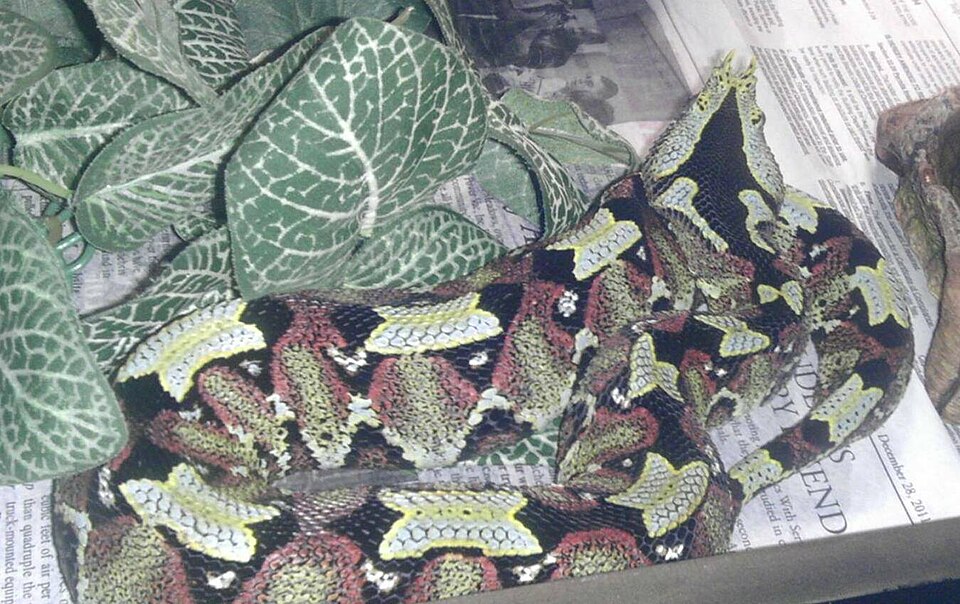
The spectacular effectiveness of bark mimicry relies heavily on the intricate color patterns that adorn these snakes’ bodies. Species like the Rhinoceros Viper display a complex mosaic of geometric patterns in shades of brown, black, blue, yellow, and even crimson that, when viewed from a distance, blend into a convincing bark-like pattern. These colors aren’t randomly distributed but are arranged in specific ways that create the optical illusion of depth, texture, and natural bark features such as lichen growth, moss patches, or fungal formations. The patterns often incorporate disruptive coloration – high-contrast boundaries between differently colored scales that break up the snake’s outline and make its body shape difficult to distinguish from the surrounding environment. What’s particularly fascinating is how these patterns remain effective under various lighting conditions in the forest, working equally well in dappled sunlight or deep shade, as the snake’s scales reflect and absorb light in ways that maintain the camouflage regardless of the time of day. Some species even possess slightly iridescent scales that mimic the subtle light-reflecting qualities of certain fungi and lichens found on tree bark.
Hunting Strategy: The Art of Ambush
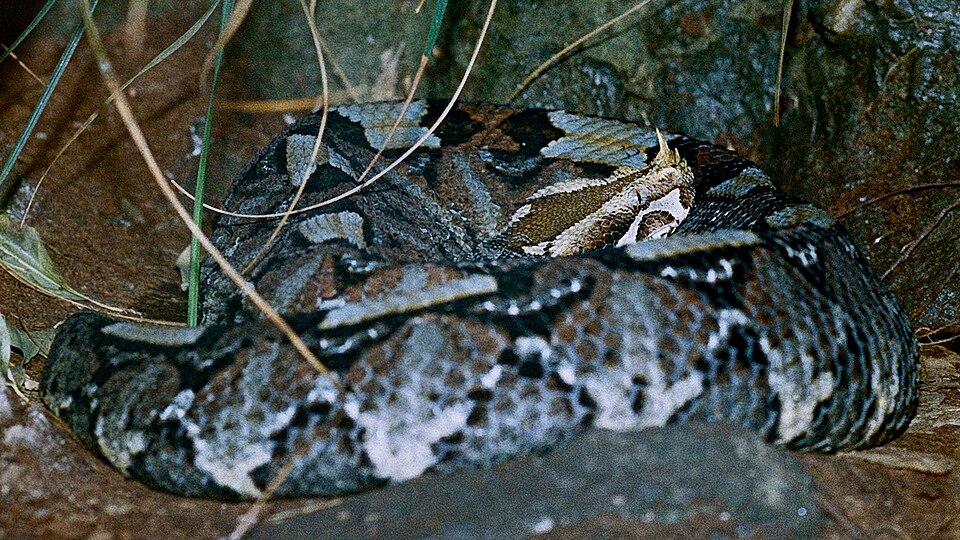
Bark-mimicking snakes are the quintessential ambush predators, employing a hunting strategy that combines extraordinary patience with explosive speed. These serpents may remain completely motionless for days at a time, coiled against a tree trunk or branch, virtually invisible to the small mammals, birds, amphibians, and lizards that constitute their prey. This stationary hunting approach conserves valuable energy while maximizing the element of surprise, with some species documented remaining in the same ambush position for weeks awaiting suitable prey. When a potential meal ventures within striking range – typically just a few body lengths away – the snake explodes into action with a strike so rapid it can barely be tracked by the human eye, often reaching speeds of up to 175 miles per hour. Most bark-mimicking vipers possess thermosensitive pit organs that allow them to detect the infrared radiation (body heat) of warm-blooded prey, enabling them to strike with precision accuracy even in complete darkness. After a successful strike, the snake’s venomous bite typically immobilizes prey quickly, allowing the snake to release and then track the dying animal before consuming it whole – a strategy that minimizes the risk of injury during prey capture.
Venom Composition and Hunting Efficiency
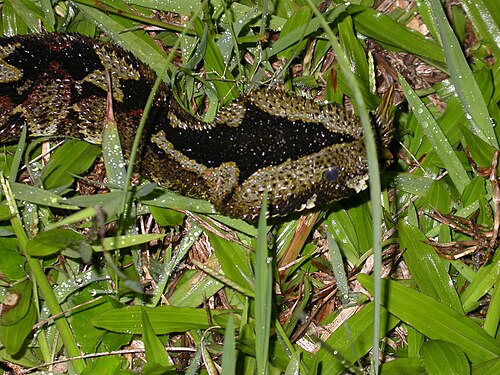
The venoms produced by bark-mimicking vipers are among the most complex biochemical compounds in the natural world, containing dozens of different proteins and enzymes specifically evolved to immobilize prey quickly. These hemotoxic venoms primarily target the circulatory system, destroying blood cells, disrupting coagulation, and damaging blood vessel tissues to induce rapid shock and hemorrhaging in prey animals. The Gaboon Viper, a master of bark camouflage, possesses the longest fangs of any snake (up to two inches) and can deliver the highest venom yield of any venomous snake – up to 600mg in a single bite, far more than needed to kill several adult humans. This overwhelming venom delivery system ensures that even if the snake only manages a glancing strike on fast-moving prey, sufficient venom is usually injected to ensure the target doesn’t escape far before succumbing. The biochemical composition of these venoms has evolved specifically to target the common prey species in each snake’s habitat, with variations in venom chemistry observed even between populations of the same species that hunt different prey assemblages in different regions.
Habitat Selection and Preferred Hunting Grounds

Bark-mimicking snakes display remarkable selectivity in choosing their ambush locations, with each species favoring specific microhabitats that maximize their camouflage effectiveness. The Rhinoceros Viper typically selects trees with rougher, more textured bark that better match its intricate scale patterns, often preferring positions near game trails, water sources, or fruiting trees that naturally attract potential prey. Research has shown that individual snakes will repeatedly return to successful hunting locations, suggesting they maintain mental maps of productive ambush sites within their territories. Some species show a preference for particular heights above the forest floor, with arboreal specialists positioning themselves on branches at levels corresponding to the movement patterns of their preferred prey species. Interestingly, bark-mimicking snakes will often change their preferred hunting locations seasonally, moving to different microhabitats as prey availability shifts with changing weather patterns or breeding cycles. This sophisticated habitat selection demonstrates that effective camouflage is not merely a passive trait but part of an active hunting strategy requiring complex decision-making about where and when to deploy their remarkable disguise.
Behavioral Adaptations That Enhance Camouflage

Beyond their physical appearance, bark-mimicking snakes employ a suite of behavioral adaptations that significantly enhance their camouflage effectiveness. Perhaps most important is their almost supernatural ability to remain completely motionless for extended periods – sometimes days or even weeks – with even their breathing so subtle that it causes no visible body movement. When positioning themselves on a tree, these snakes carefully align their body patterns to match the directional flow of the bark’s natural patterns, creating a seamless integration with their background. Many species have developed a distinctive coiling posture where they arrange their body in geometric shapes that mimic natural features of tree bark, such as knots or branch junctions. When threatened or disturbed, rather than fleeing immediately, these snakes often freeze completely, relying on their camouflage as their first line of defense. Some species have even been observed performing a slow, rhythmic swaying motion when breezes move nearby vegetation, timing their movements to match the natural motion of their surroundings – a sophisticated behavior that prevents them from standing out as suspiciously static elements in an otherwise moving environment.
Predators and Threats to Bark-Mimicking Snakes
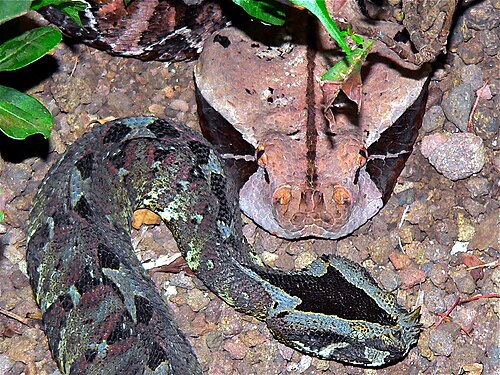
Despite their exceptional camouflage, bark-mimicking snakes still face numerous natural predators that have evolved countermeasures to detect these hidden serpents. Large birds of prey, particularly snake eagles and hawk-eagles, possess exceptional visual acuity that can sometimes penetrate the snake’s disguise, especially when hunting from above, where the camouflage is less effective. Certain mammals with keen olfactory senses, such as honey badgers, mongooses, and wild pigs, can detect these snakes by scent rather than sight, circumventing the visual camouflage entirely. King cobras and other ophiophagous (snake-eating) snakes represent another significant threat, as they have evolved specialized hunting techniques specifically for locating and consuming other serpents. Beyond natural predators, bark-mimicking snakes face increasing anthropogenic threats, including habitat destruction as forests are cleared for agriculture and development, direct persecution by humans who kill them out of fear, and collection for the exotic pet trade, where their spectacular appearance makes them highly valuable. Climate change represents an emerging threat, as shifts in temperature and precipitation patterns may disrupt the delicate balance between these snakes’ camouflage and their specific habitat conditions, potentially reducing the effectiveness of their evolutionary adaptations.
Research Challenges and Scientific Discoveries
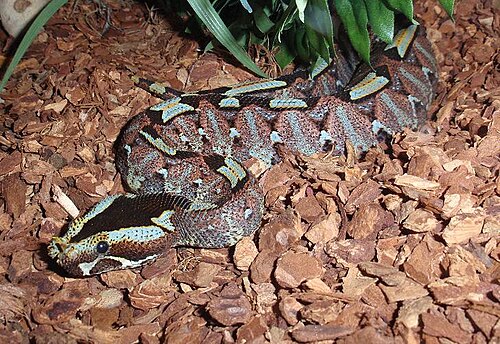
Studying bark-mimicking snakes presents unique challenges for researchers, as their exceptional camouflage makes them extraordinarily difficult to locate in the wild, even for experienced herpetologists. Field studies often require specialized techniques such as radio telemetry, where surgically implanted transmitters allow scientists to track individuals that would otherwise disappear completely into their environment. Recent research has revealed fascinating aspects of these snakes’ ecology, including the discovery that some species can adjust their coloration slightly over time to better match seasonal changes in their bark substrate, suggesting a degree of physiological control over their camouflage that wasn’t previously recognized. Advanced genetic studies have identified specific gene complexes responsible for the intricate scale patterns, opening new avenues for understanding how complex camouflage evolves at the molecular level. Perhaps most intriguing are recent findings suggesting that the brain structures involved in controlling the snake’s remarkable ability to remain motionless for extended periods show specialized adaptations not found in more active snake species, providing a neural basis for their extraordinary patience. Ongoing research using high-speed cameras has documented striking speeds that exceed previous estimates, with some species achieving accelerations of their head during strikes that exceed 100 G-forces.
Conservation Status and Protection Efforts

Many bark-mimicking snake species face significant conservation challenges, with habitat loss representing the most severe threat as tropical and subtropical forests continue to be cleared at alarming rates. The Rhinoceros Viper is currently listed as Near Threatened on the IUCN Red List, while other bark-mimicking species have varying conservation statuses depending on their range and specific threats. Conservation efforts face complicated challenges because these snakes’ exceptional camouflage makes population assessments extremely difficult, with traditional survey methods likely underestimating true population sizes. Several international conservation organizations have established specialized projects focused on viper conservation, combining habitat protection, local education programs, and research initiatives to better understand their ecological requirements. In some regions, innovative conservation approaches include working with local communities to establish sustainable ecotourism operations where visitors can safely observe these remarkable snakes in their natural habitat, creating economic incentives for protection. Ex-situ conservation programs in specialized reptile facilities maintain captive breeding populations of several threatened species, preserving genetic diversity and developing husbandry protocols that could support potential reintroduction efforts if wild populations continue to decline.
Cultural Significance and Human Relationships

Bark-mimicking vipers have figured prominently in the cultural traditions, mythology, and traditional medicine systems of many indigenous peoples living within their range. In various West African traditions, the Gaboon Viper’s intricate geometric patterns have inspired textile designs and artistic motifs that appear in ceremonial masks and carvings, with the snake often symbolizing hidden wisdom or protective power. Many local communities have developed sophisticated traditional knowledge about these snakes, including their habits, effective treatments for their bites, and methods to safely remove them from human dwellings without killing these ecologically important predators. Unfortunately, widespread fear of venomous snakes has also led to indiscriminate killing, with many people unable to distinguish between dangerous species and harmless mimics, resulting in the unnecessary destruction of many snakes. Modern relationships between humans and these serpents are evolving through educational outreach by conservation organizations, which emphasize the ecological importance of these predators in controlling rodent populations and maintaining forest health. For wildlife photographers and nature enthusiasts, successfully spotting a perfectly camouflaged bark-mimicking snake in the wild represents one of the ultimate achievements, testifying to both the perfection of the snake’s disguise and the observer’s exceptional perceptual skills.
The Future of Bark-Mimicking Snakes in a Changing World
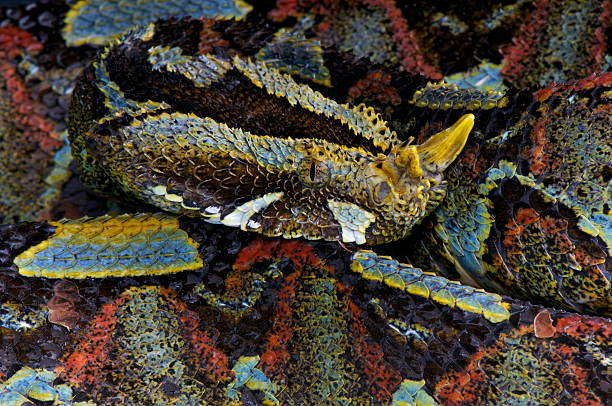
The remarkable evolutionary adaptations that have made bark-mimicking snakes such successful ambush predators now face unprecedented challenges in the Anthropocene era. Climate change threatens to alter forest ecosystems at rates potentially too rapid for these specialized reptiles to adapt, potentially creating mismatches between their camouflage and changing bark textures or colors. Continued deforestation fragments their habitat, isolating populations and reducing genetic diversity necessary for adaptive evolution in response to changing conditions. However, there are hopeful signs as well – increased scientific understanding of these snakes’ ecological requirements is informing more effective conservation strategies, and growing public fascination with their extraordinary camouflage abilities is creating new advocates for their protection. Emerging technologies such as environmental DNA sampling may soon allow researchers to monitor populations without actually having to locate these nearly invisible reptiles, providing crucial data for conservation planning. The future of these remarkable evolutionary marvels will ultimately depend on humanity’s success in preserving the forest ecosystems they inhabit and our willingness to coexist with creatures that, despite their potentially dangerous venom, represent one of nature’s most extraordinary examples of evolutionary specialization. With proper protection, future generations may still have the opportunity to experience the wonder of finally spotting a perfectly disguised serpent that has been watching them all along from what appeared to be nothing more than cracked tree bark.
In the intricate tapestry of evolutionary adaptations, the bark-mimicking snakes stand as testament to the remarkable power of natural selection to shape living organisms into forms of extraordinary specialization. Their ability to transform their bodies into near-perfect replicas of tree bark represents one of nature’s most sophisticated examples of cryptic camouflage – a living optical illusion that has been refined over millions of years. As we continue to explore and understand these remarkable reptiles, they remind us that sometimes the most extraordinary adaptations in nature are those designed not to be noticed at all. In their patient stillness and perfect disguise, these serpents embody an evolutionary magic that continues to fascinate scientists and nature enthusiasts alike, challenging our perceptions and rewarding those observant enough to glimpse one of nature’s most perfectly camouflaged predators.




